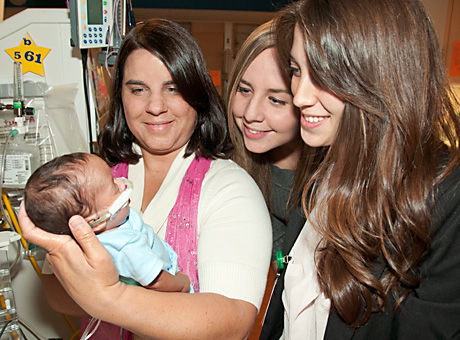
A study led by Roberta G. Pineda, PhD, far left, has documented developmental differences between premature babies in the NICU and full-term babies.

A study led by Roberta G. Pineda, PhD, far left, has documented developmental differences between premature babies in the NICU and full-term babies.
Premature infants are born into a world their tiny bodies often are not ready for. Developmental differences between those babies and full-term infants often are apparent prior to a preemie’s discharge from the neonatal intensive care unit (NICU), researchers at the School of Medicine have documented.
The study points to opportunities for therapeutic interventions — even in the first few weeks of life — to improve premature babies’ long-term outcomes.
The research, which focused on infants born at least 10 weeks early, is available online and will appear in an upcoming issue of the Journal of Pediatrics.
A study led by Roberta G. Pineda, PhD, has documented the developmental differences between premature babies in the NICU and full-term babies. The research points to opportunities to intervene in the NICU, to improve preemies’ long-term outcomes.
“We found that by the time premature infants are at or near their original due dates, they have significant developmental differences compared to full-term infants,” says first author Pineda, research assistant professor in Washington University’s Program in Occupational Therapy.
The study reports on 75 premature infants at St. Louis Children’s Hospital who were evaluated in the NICU at 34 weeks gestation and again at 40 weeks, the length of a full-term pregnancy. The babies also received an MRI to detect brain injuries that could be related to premature birth.
Comparing the preemies to full-term babies, researchers found major differences in muscle tone, reflexes, stress levels, the ability to be soothed and handled by caregivers and the ability to visually track objects and people in the NICU.
Comparing the preemies to full-term babies, researchers found major differences in muscle tone, reflexes, stress levels, the ability to be soothed and handled by caregivers and the ability to visually track objects and people in the NICU.
Pineda says one of the biggest differences involved the fact that premature babies typically have low muscle tone early in development.
“Full-term babies tuck in their legs and arms close to the body, and they tend to stay like that much of the time for several weeks after birth,” Pineda explains. “But premature infants tend to have lower muscle tone, making them more likely to assume an extended position while they are in the NICU.”
The flexed position that is assumed at birth is supported by the cramped uterine environment in the final trimester of pregnancy. However, when infants are born early, they miss this experience and the brain has not yet matured to the point that it can signal the infant’s muscles to become flexed. Pineda says that the extended positioning in the NICU can interfere with the babies’ ability to calm themselves and to coordinate movements smoothly.
“Low muscle tone can be an extra challenge to overcome in order to achieve normal developmental motor skills, like rolling over, sitting up and crawling in the first year of life,” she explains.
Typically, premature infants are released from the hospital when they can stay warm without an incubator, be fed by mouth and are able to breathe well without supplemental oxygen, Pineda says.
But she suggests interventions in the NICU may help them catch up with full-term babies who have had more time to develop and grow in utero. For example, more intensive physical and occupational therapy might help babies get stronger before they are discharged from the hospital, and she says it’s important that the therapy continues when the babies go home.
“Even when critical medical problems are resolved, our results suggest it’s important to continue with physical, occupational and speech therapy,” Pineda says. “There are such drastic changes in the first year of life, and now we know that in preemies those changes begin to occur even before their due date. That presents a great opportunity to intervene and to help these babies grow so they can make the same milestones as their full-term peers and reach their full potential.”
Pineda is continuing to work with premature babies as part of a large study funded by the National Institutes of Health (NIH). Terrie E. Inder, MD, professor of pediatrics, is the study’s principal investigator. Those babies will return for follow-up testing at 2, 4 and 6 years of age.
Testing the babies over time can help determine whether therapies and interventions have helped them get on a normal developmental path or if differences between premature babies and their full-term counterparts continue to linger into early childhood.
“Those follow-ups will give us valuable information about how different interventions may influence a baby’s developmental trajectory,” Pineda says. “We need to learn what to expect at specific time points, even in premature babies, because that will tell us when babies are on target or whether they may need more intensive interventions to catch up.”
NIH RO1 HD 057098, NIH/NICHD P30 HD062171